They are in Creek, Chickasaw and Choctaw art, but were also seen by early European explorers
by Richard L. Thornton, Architect and City Planner
They are described in the art and oral histories of the Creek, Chickasaw and Choctaw Peoples. They were described by European explorers up until the early 1700s. Most were quickly exterminated by fire arms, but some are back with us again . . . living in remote forests or the ravine in my back of my house. LOL YET . . . contemporary wildlife biologists and academicians refuse to admit that they ever existed. One of those “cryptid” felines was back in my ravine, hunting last night. I had last seen his kind in 2018. Why would a critter that looked like an economy-size Cheetah, be hunting turkeys behind my house?

About 11 PM one night, late in November 2018, I heard a ruckus in the back of my house. Mind you, it is not your regular backyard, but a ravine the drops about a hundred feet to a small stream. The ruckus was coming from about 50 feet from my house. About 15 wild turkeys were squawking frantically and flapping their wings, as they stood on top of a fallen red oak tree. The tree had wedged in a fork of a live tree, meaning that the turkeys were about 5 feet off the ground.
There was a silhouette moving beneath the tree trunk. I shined a bright LED light on it. My gosh! It looked like one of those jungle cats in Central and South America. It was a little bigger than a typical bobcat . . . had a long, lanky body . . . long tail and was spotted! It was not spotted a distinctly as a jaguar or ocelot, but much more distinctly than a bobcat. Of course, also, bobcats do not have long tails.
Eventually, by swatting with its front arms, the strange feline was able to spook one of the turkeys. The cat jumped into the air and grabbed the turkey with his teeth as the bird try to fly off the log. The cat then quickly disappeared into the darkness, carrying the now-dead turkey. What in the world had I just seen?
Unfortunately, it would be August of 2020 before I would be given a Polish Army binocular infrared camera-video camera as a birthday gift by a female European architecture professor, who I had shown the wonders of Track Rock Gap.
I posted an inquiry on the former “People of One Fire” website. Within a few hours, several people who had seen the breed of cat that I had seen, responded . . . from as far away as Arkansas and southern Florida. One sent me a photo. Yep! It was the same species of wildcat.
The man from Arkansas said that the wildlife rangers and biologists refuse to admit that this wildcat exists, although it has been seen by thousands of people. The creature has the odd lifestyle of migrating around the Southeast seasonally, so is never in one location for very long. It seems to be a cross between a jaguarundi and an ocelot. I later learned that in body proportion and markings, it was identical to the American Cheetah . . . which was supposedly extinct.
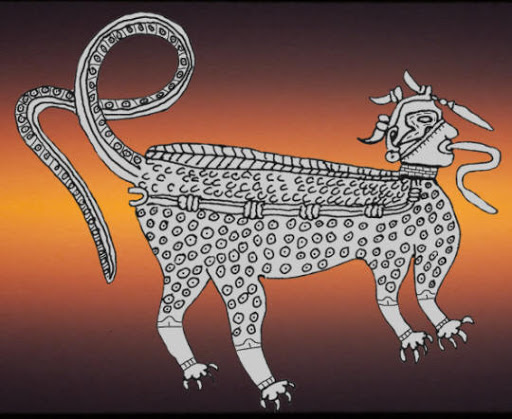
Definitely not a bobcat, but very dead
I had seen this “tropical” cat before . . . but dead. In 2013, a Chitimacha family in Louisiana drove up to visit my cabin in the Georgia Mountains after seeing me on the History Channel. They wanted to thank me personally for affirming their own tribe’s oral memories of immigrants from Mesoamerica. In Alabama, they noticed the freshly dead carcass of a large, strange-looking cat on the side of the highway. They said that was bigger and slimmer than a bobcat, spotted like a jaguar and had an extremely long tail.
They packed it in ice and dropped it off at a taxidermist in Dahlonega. Thinking it to merely be an unusually marked bobcat, I did not ask to see the carcass before they drove into Dahlonega to have it worked on. They stayed in a motel in Dahlonega, while the taxidermist preserved it.
I had breakfast with them on the morning of departure and accompanied them to the taxidermist on the way back to the cabin. The taxidermist’s finished work was astonishing. It was a member of the cat family with the physique of a mountain lion . . . but much smaller . . . but the spots of a jaguar. It seemed to belong in Central America or the Amazon Basis . . . but there it was!

Mountain lions
Then there is the situation with the mountain lion. You go online and read multiple articles stating that “there have been no credible sightings of mountain lions north of southern Florida.” Others will say that there is no such thing as a black mountain lion. Both authoritative statements are horse manure.
“Cougars are extinct in North Carolina. There are no known cougars in North Carolina,” stated Jodie Owens of the N.C. Wildlife Resources Commission. “What people claim to be cougars are bobcats and domestic cats.” Fact-check Mr. Owens on the web. There are dozens of daytime and night-time photos of mountain lions (cougars) in North Carolina.
The Georgia Wildlife Commission website states, “The U.S. Fish and Wildlife Service has recently proposed that the eastern cougar be considered extinct in the wild. To date, no credible physical evidence (carcasses, trail camera pictures, photographs, film footage, etc.) has been found to substantiate the existence of a population of mountain lions in Georgia.” On the same webpage, the agency then mentions that a deer hunter SHOT a mountain lion near LaGrange, GA in 2008, and was fined $2000 for killing the animal. In 2016, I saw what was definitely a cougar beneath my bedroom window at the cabin near Amicalola Falls.
Three mountain lions have been REMOVED from Metro Atlanta in the past five years, but the same agency in Georgia, which relocated the mountain lions to Florida, publicly made the statement above. In contrast, state wildlife personnel in Kentucky and Alabama have posted photos of mountain lions in their state. What in the world is going on with these state and federal wildlife bureaucrats? Many people in the southern Appalachians have seen mountain lions there. Many more have heard them.
Four years ago, a large mountain lion was prowling immediately beneath my bedroom window two nights in a row. The dogs would wake me up and I would look out the window and there he or she was. I never saw the big cat again, but it was definitely a mountain lion. I frequently see bobcats at night. They are very different in appearance than mountain lions. As for there not being black mountain lions, look at their photos online! Kentucky and Alabama wildlife rangers also have posted photos of black mountain lions in their state.

Pre-Columbian indigenous art in the Southeast
Numerous artistic portrayals of wild members of the cat family survive in Southeastern indigenous art. Most look like the long lanky cat with a small head, pronounced spots and a long tail that I saw on my property. Archaeologists label these images “jaguars,” but jaguars have massive, squarish skulls and stockier body proportions. However, there are some artistic portrayals that are definitely jaguars. Bobcats are also portrayed, but usually with shorter tails than are typical today, like the effigy pot above in my collection. They look more like the lynx of Europe.
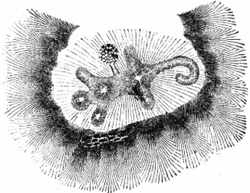
A common feature of Pre-Columbian art in the Midwest and upper Southeast is called the “Underwater Panther” by archaeologists. What these paintings and carvings seem to show is either a rug made out of a cougar skin or a flying cougar. Whatever the case, the artistic portrayals resemble a cougar.

BUT . . . there are also two animals portrayed in a few sculptures and engravings which is unlike any living wild feline in the United States today. One had a large head and exposed fangs, but not spots. The fangs are not as long as a saber-tooth cat . . . more like the extinct American Lion. That’s odd, though, because supposedly the Saber-tooth cat and American Lion became extinct about 10,000 years ago. Archaeologists have labeled the fanged-cat a bobcat. Evidently, they have never seen a bobcat. The bobcat does have upper and lower fangs, but they are usually not visible. The fangs seat inside their cheeks, not outside.
The other large cat portrayed in North American indigenous art is either a jaguar or an ocelot. It is brightly spotted, stoutly built and has a long tail. The “jaguar” art is found as far north as southern Illinois and as far east as South Carolina.
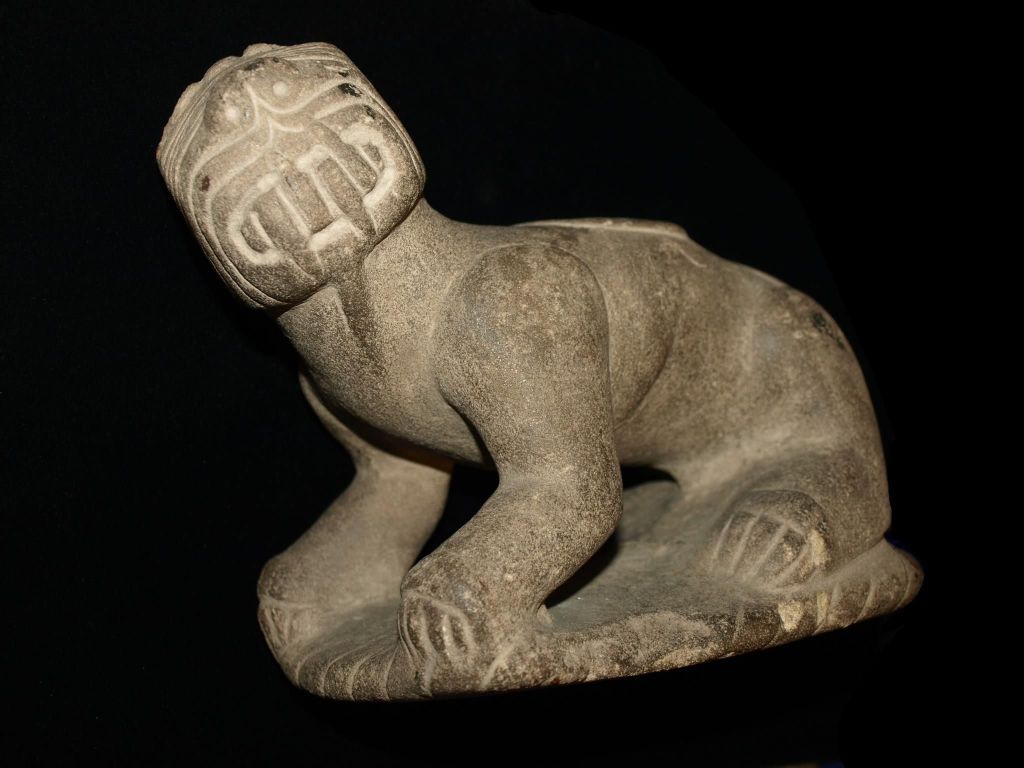
Large cats in Creek oral literature
Uncle Remus Tales: A well concealed fact is that Joel Chandler Harris plagiarized a published book and public archives by Federal Indian Agent Benjamin Hawkins, when writing the “Uncle Remus Tales.” The only original material in his short stories are Uncle Remus and the two children on the plantation. The animal stories came straight from the writings and archives of others. Harris did not grow up on a plantation, but in poverty within a single mother household in Eatonton, GA. He did work as a teenager during the American Civil War at a newspaper office, which was located on a plantation.
The Creek children’s stories as translated and transcribed by Benjamin Hawkins include a Brother Bobcat, a Brother Tiger and a Brother Panther. Brother Tiger is presumably a jaguar. Brother Panther is presumably a black mountain lion.
Several “modernized” versions of the Uncle Remus Tales, which claim an African origin for the stories, change the cats’ names to Brother Cheetah, Brother Tiger and Brother Lion . . . the self-styled, politically correct authors, thinking themselves to be “oh so clever.”

Creek Migration Legends: The Creek Migration Legends (June 7, 1735) were translated by Kusapanakesa (Mary Musgrove) and transcribed by Georgia Colonial Secretary Thomas Christie. Kusapanakesa means “Little Coosa Valley Girl.” She was NOT from Coweta or Tuckabatchee as contemporary references tell us.
What is really interesting is that the Creek migration legends contain no deities, personal names, supernatural animals or implausible events. They describe the migration of the Kaushete (Tekeste in Mexico) from the Orizaba Volcano in western Veracruz to the Mississippi River Basin then southeastern Tennessee then western North Carolina then northern Georgia. The Kaushete originated from a region where the jaguar, ocelot and puma (mountain lion) were indigenous.
While migrating from the Mississippi River Basin to the Southeastern Tennessee, the Kaushete encountered a cat, which was much larger than any then had seen before. The story calls it a Man-eater. Its body was longer than a man was tall. It could overpower small hunting bands. It was larger and different looking than any cats that they had seen before in Mexico or the Southeast. Its description matches exactly the description of the Great American Lion, which paleontologists tell us went extinct about 10,000 years ago.
They captured the Man-Eater by digging a large pit and covering it with saplings. They placed a dead deer on top of the trap. The Man-Eater pounced onto the deer and fell into the trap. After they killed the Man-Eater, they kept its long fangs and claws as memories of the event. The long fangs do not sound like even a jaguar.
The Creek languages have multiple words for the large cats. Seminole, Koasati and Itsate words are more useful than Muskogee words, because the Muskogee Creeks have been in Oklahoma for 186 years and forgotten much about the world they left behind in Georgia. Their names of animals have been modified by the animals, who they live in Oklahoma today.
Here are the Eastern Creek words for the large cats: (1) Kowe – a large species of lion (2) Kacci – Translated into English as Tiger, it originally meant a large spotted cat . . . the jaguar. (3) Kowece – A small lion or Mountain Lion (4) Kowece-lvste – Black Panther (5) Kowakuse – Bobcat (6) Kacciche (ocelot or our mystery cat).


John Lawson’s detailed description
John Lawson traveled extensively through the back country of South and North Carolina in 1700 and 1701. He then wrote a book about his fascinating journey, which included a comprehensive description of the fauna and flora of the Southeast. The book, A New Voyage to Carolina, has been republished and is available from several booksellers.
Lawson listed four cats in the wild, none of whom matched the appearance of the spotted cat that I saw in my woods. [pp.83-84] These were the:
Tiger – This was the largest of the cats in the Southeast in 1700, but was rarely seen by hunters and soon extinct. Lawson stated that it was rarely seen in the Carolinas and was more common in the Gulf Coast region. The cat’s appearance as described a few times by trappers seem to match the jaguar. The Jaguar’s height at the shoulders was 21-30 “ ( 25-55 cm). It was spotted rather than striped like a true tiger.
The original name of the Alabama River was the Albalamaha, which is an Itza Maya word meaning “Place of the Jaguar – River.”
Panther – This was a very large cat, which had a reddish color, the same as an African lion. Lawson said was it was the height of a large greyhound, which would be about 30 inches (76.2 cm). That matches the size of the contemporary jaguar. This creature was most common in the Piedmont. Cougars today reach a height of 21 to 27 inches (54-68 cm) at the shoulder.
The favorite foods of the panther were deer and feral swine. When these animals were hunted to near extinction, the panther also disappeared. In 1701, the panther was very commonplace in the Southeast, but was being heavily hunted for his hide by both Native Americans and Europeans.
Cat-a-mount – Lawson described this cat as being smaller than the Panther, but similar in color and body proportions. This predator only lived in the mountains. Its size suggest that this is cat that now lives in southern Florida and in West today. It also lives in the Appalachian Mountains and Piedmont, but state wildlife officials refuse to admit it.

Wildcat – This creature was obviously the Bobcat, because Lawson said that its tail was only about four inches (10 cm) long. Its shoulder height is 14-15” (36-38 cm). The Bobcat’s scull is more “squarish” like a jaguar. Lawson described the Wildcat is being larger, stronger and more aggressive than the European Lynx. It would kill adult deer by driving its fangs into the neck or throat of the deer then sucking blood.
Jaguarundi – This cat matches exactly the appearance of the wild cat I saw hunting turkeys, but it has a smooth gray coat of fur, not spotted. There are some jaguarundis in south Florida that were accidentally introduced to the region in the 1940s.

Mystery Cat – There are numerous sightings of a spotted, medium sized, long tailed cat in the Southeast, that no biologist seems to know exists. Their appearance exactly matches a large variety of jaguarundi, which officially only lives in the Amazon Basin. They are spotted like a jaguar. Latin American biologists theorize that they are the result of cross-breeding between ocelots and jaguarundi’s . . . or perhaps jaguars and jaguarundis.
Unlike the other medium-sized American felines, this cat seems to do just fine in cold weather. It has been spotted as far north as Missouri, West Virginia and Maryland. This could be a new hybrid species that developed out of the mating of ocelots and jaguarundi’s. Its head and tail are very different from those of a Bobcat.
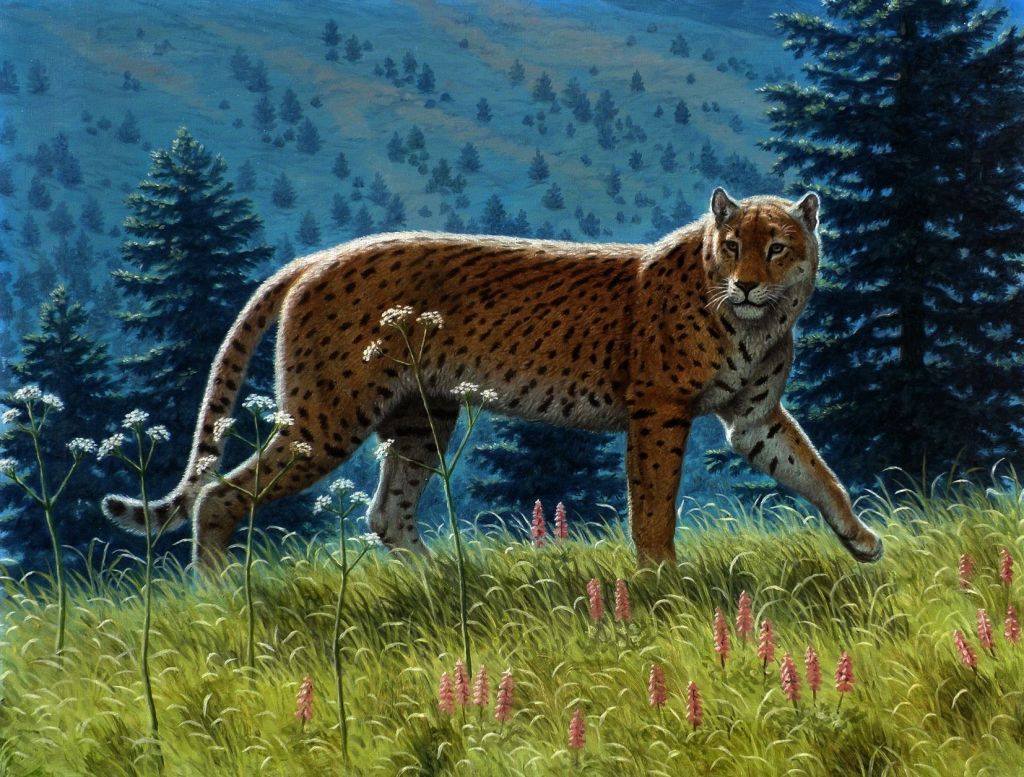
Conclusion
It is very apparent that the jaguar and the American Lion were still living in the Southeast, when Europeans first began colonizing Southeastern North America. South American and Central American jaguars prefer watery landscapes near fresh water rivers and swamps. Thus, the jaguar last habitat in the Southeast was probably the Coastal Plain, west of the Savannah River. The American Lion was rarely seen outside of the bounds of present-day Georgia. However, 2500 years of increasingly dense human occupation had vastly reduced the numbers of large cats from earlier times. The catastrophic extermination of the vast herds of deer, buffalo and elk that once roamed the region very quickly resulted in the extermination of this branch of the jaguar’s territory.
The identity of the Creek Migration Legend’s “Man-eater” and Lawson’s “panther” is much more enigmatic. In indigenous art, it is clearly portrayed as having upper fangs extending over its lips, but not nearly as long as the Saber Tooth Cat. This feature clearly matches the Great American Lion that was officially extinct 10,000 years ago.
Some biologists admit that the jaguar may have originally ranged as far as southern Louisiana, but Lawson said the panther was west of the Savannah River and also described the lion-like cat as being slightly bigger than an American “tiger.” Lawson’s “panther” did not have spots, but a coat like that of an African lion or a cat-a-mount.
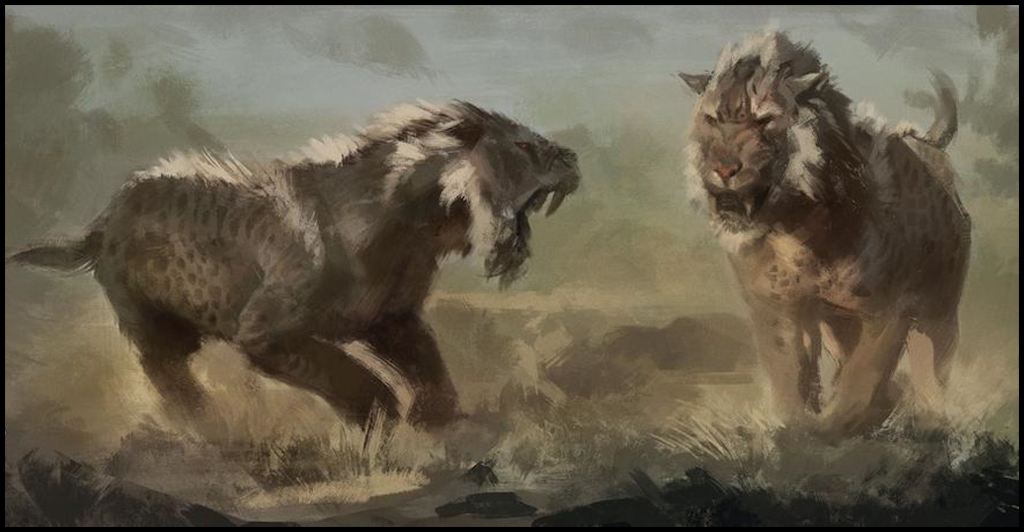
What the indigenous art, portraying the “Man-eater” cat, most closely resembles is Xenosmilus or Cookie-Cutter Cat, whose bones were recently discovered in Florida. It was smaller than the Saber Tooth and had much shorter fangs, plus retractable claws. It matches the indigenous art, which portrays such a creature, but Lawson made no mention of exposed fangs. Both Xenosmilus and the American Lion were thriving when humans entered the Americas. One or both could have survived long enough to still be in the indigenous cultural memory in the centuries immediately prior to the arrival of the Spanish.
On the other hand, the Creek’s man-eater and Lawson’s Panther may have been a smaller descendant of the American Lion . . . which could well be the ancestor of the Mountain Lion. Lawson’s description pretty much matches the description of large and very rare indigenous lion, which once preyed on elk and Woodland Buffalo. By 1700, it was at the verge of extinction, and soon starved out of existence due to the over-hunting of deer and buffalo.
The Truth Is Out There Somewhere

I saw a mountain lion in my backyard a few years ago, and my neighbors have seen black mountain lions as well. My son-in-law encountered a mountain lion at his parents’ cabin near Blue Ridge. An owner of a business nearby called the Ga. Department of Natural Resources to report seeing a mountain lion, and they told her it must have been some sort of “messed-up dog,” even though she saw it climb a tree. LOL Except for the mountain lion my son-in-law saw, all of the other sightings have been in the Joe Black Road/Asbestos Road/ area of White County.
LikeLiked by 1 person
Here, Arizona, if you spot a balam, a jaguar, do not tell Game and Fish. Each time they heard of one, they tried to trap it to check it, and the animal died. I think that may be the case in Georgia, but they fear hunters.
In the Northeast, wolves were exterminated tho many people have tried to protect them. Net result us the coydog, which is a much worse predator than the wolf. People sick of losing livestock and even children (coyote is eater-of-souls, eater-of-infants) will not report a wolf. Wolf is sacred in the cultures because it’ll hunt down coyotes and cougars and kill them. Wolf is sacred, but when not threatened by humans becomes a scavenger. Wolf is better off understanding that while we pray to his Heavenly aspect, he also makes great fuzzy underwear.
Cougar is a demonic aspect that will hunt humans, as we see in places like California. In the Demon road valley, Penna, there’s an asgina, demon, cougar, who is black and holes for eyes. If you see him, you’ll likely die. I saw him 3 times one winter and each time nearly was killed. He likes to hang out near a small family cemetery (once a burial mound of the last of the village once there) and a black oak (the old one did over a century ago and was replaced by one from that tree) that was used to hang a witch maybe 300 years ago. Her son, a shongili, was beheaded and the body buried under the oak.
The eagle head monument to the west of the valley points west, a warning to not enter the valley after dark. American Indians who lived in the valley weren’t there because they wanted to be. They were mengwe, outcasts. There are 3 burial places in the valley, 2 so old nothing is left but stone tools. No Wicca will stay in the valley after dark. niio
LikeLiked by 1 person